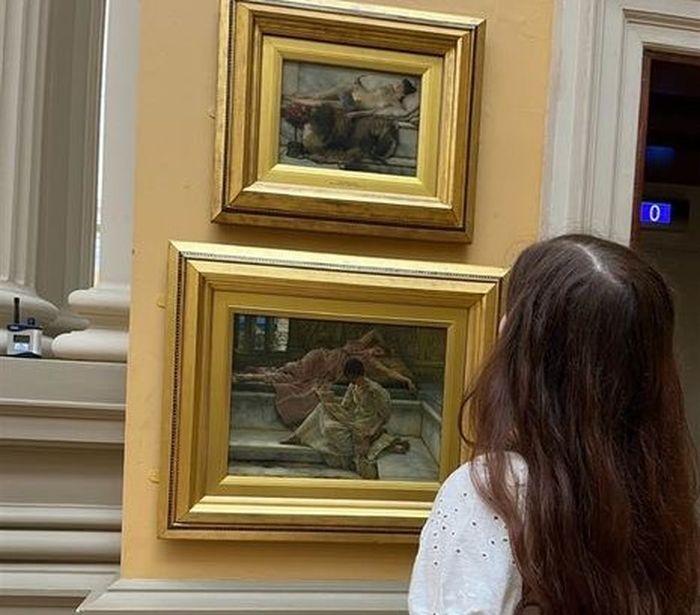‘Walking around Robinson is automatically humbling’: college architecture and the psyche
Izzie Silverman reflects on how the aesthetics of your college can impact your experience

“It would be hard to stay humble in a place like this,” says Anisa, as we emerge from the Old Library into Pembroke College’s Old Court. I look at her. Her face is lit dimly by the golden glow emitting from the chapel’s mellowing windows, a honey-gold that permeates across the courtyard. The cloisters slouch languidly, splashed with pigments of red and blue thrown from the chapel windows. In a limbo of consciousness following a lecture on Ed Snowden, I feel as though suspended in a beige Modigliani background. Half-blended, I trespass the hush, afraid to cause disruption.
The truth is, we are trespassers. We aren’t Pembroke students, but Robinson. We aren’t accustomed to golden brick, but very used to red. I get what Anisa means: in these old colleges, the prestige of the university is inescapable. This labyrinth of courtyards envelops you, ensuring you are perpetually confronted with history — exposed beams, worn cobbled steps and stone, stained glass, royal statuary, gargoyles even. The whispers of the past, of former youth and current “greats”, are ubiquitous and incessant. The pressure to make the same of yourself is therefore imminent.
“Built in 1977, Robinson has not had as much time to churn out its own list of ‘greats’ — the whispers are much quieter, the staircases not yet worn”
The same cannot be said of the “brick colleges”. Robinson College is an architectural snapshot of the transition between modernism and post-modernism, attempting to combine 70s brutalism with features reminiscent of Cambridge’s older colleges — wood panelling, bright brick likened to Johns’ Tudor build, and a gate tower above the Porter’s Lodge. In reality, the greatest compliment of the building is that it resembles “a red-brick fortress,” (claustrophobic and inescapable), with it more commonly being compared to a car park (ugly and inescapable). Built in 1977, Robinson has not had as much time to churn out its own list of “greats” — the whispers are much quieter, the staircases not yet worn. It is relatively easy to stay humble there — Byron never stepped foot in Robinson.
With this idea of staying humble, Anisa tapped into the way in which college appearance inevitably informs the personality of the college itself. The significance of aesthetics and positioning (and how architecture crucially marries these two things) upon wellbeing and the psyche is not a new concept — take the ancient art of feng shui. However, when applied to the unique circumstance of a Cambridge college — an umbrella under which approximately 400 students eat, sleep, work, and socialise in proximity, lives littered with anachronistic tradition — this fact takes on greater significance. Architecture fundamentally informs the way colleges function as a collective, generating a group personality that is distinct both within the college and outside, as it performs relative to others.

This can be seen to be a direct result of college architecture — Jesus College’s sportiness is enabled by the sports pitches which sit alongside student rooms; Robinson’s underground bop room equipped with a bar and DJ booth encourages a weekly college-wide recreational gathering. As the differing facilities offered by colleges impact the way students socialise, they also impact their priorities.
This certainly goes beyond simple logistics. As college hierarchy and perception impact each college’s self-presentation, appearance is the quickest, most accessible signifier of this. With the more modern colleges, the effect can be termed “brick-college psyche”, as Churchill, Murray Edwards, and Fitzwilliam boast that they are “laid-back” on their respective prospectuses. Robinson, perhaps particularly insecure due to its status as the newest college, feels the need to demonstrate its relative immaturity — it is notorious for having the most problematic drinking societies and rugby team, somewhat obsessively clinging onto its status as “the party college”.
“Aesthetics of living directly inform the politics of living”
I am not suggesting that it is solely architecture that generates difference. Obviously, a multitude of other factors sit behind the various hierarchies that position the colleges against each other, with age, academic performance, wealth, and alumni explicitly constructing rankings. Yet it is through architecture that this positioning in the university sphere is perpetually felt by students.
As art, architecture facilitates a general canvas of impression; the physical aesthetics that we are surrounded by directly inform the way we visualise our lives introspectively. It composes the portion of the world in which we exist, something that takes on a particularly striking significance when this also informs our primary community. Aesthetics of living directly inform the politics of living, and Cambridge colleges act as a particularly interesting case study considering their unique relationship with the individual, their creation of the collective and their existence relative to each other.
 News / CUP announces funding scheme for under-represented academics19 December 2025
News / CUP announces funding scheme for under-represented academics19 December 2025 News / Cambridge welcomes UK rejoining the Erasmus scheme20 December 2025
News / Cambridge welcomes UK rejoining the Erasmus scheme20 December 2025 News / SU reluctantly registers controversial women’s soc18 December 2025
News / SU reluctantly registers controversial women’s soc18 December 2025 Film & TV / Timothée Chalamet and the era-fication of film marketing21 December 2025
Film & TV / Timothée Chalamet and the era-fication of film marketing21 December 2025 News / News in Brief: humanoid chatbots, holiday specials, and harmonious scholarships21 December 2025
News / News in Brief: humanoid chatbots, holiday specials, and harmonious scholarships21 December 2025









